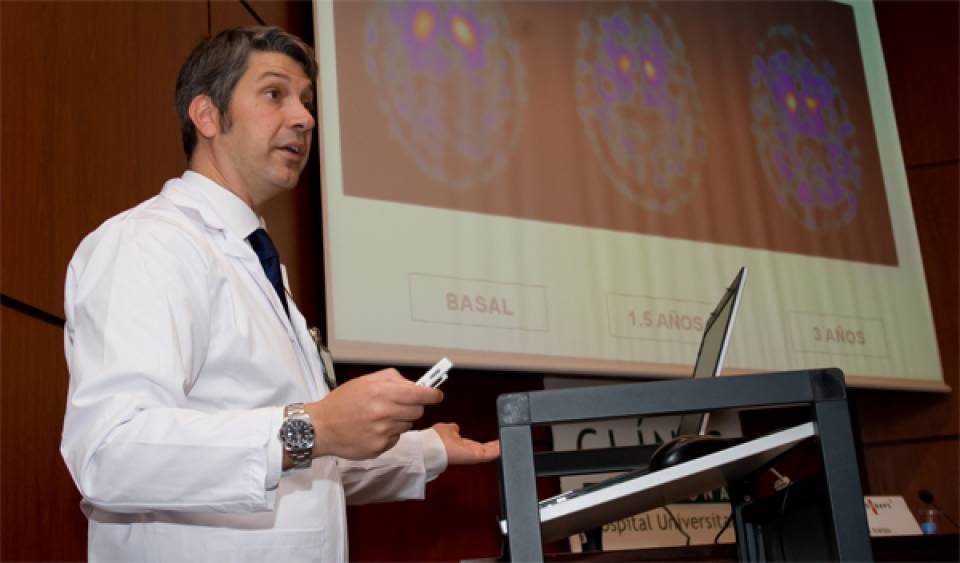The first work showed in 2006 (1) that 45% of patients who suffer this sleep disorder develop Parkinson’s disease and other neurodegenerative diseases caused by a lack of dopamine in the brain. The second article (2) discovered that neuroimaging tests that measure dopamine in the brain, such as the brain SPECT, are useful to identify patients with REM sleep disorders with increased risk of developing a neurodegenerative diseases such as Parkinson’s disease. The third study (3) applied brain SPECT to conclude that the levels of dopamine in the brain are quickly lowering over the years in patients with REM sleep behaviour disorder. This neuroimaging technique becomes the first tool to detect the disease progression at an early stage.
In the latest work (4) patients from an IRBD cohort recruited between 1991 and 2003 were followed up during an additional period of 7 years. The investigators identified the nature and frequency of emerging defined neurodegenerative syndromes diagnosed by standard clinical criteria. They also further characterised those individuals who remained diagnosed as having only IRBD, through dopamine transporter imaging, transcranial sonography, and olfactory testing. Of the 44 participants from the original cohort, 82% had developed a defined neurodegenerative syndrome by the 2012 assessment (16 patients were diagnosed with PD and 14 with DLB). Patients who remained disease-free at follow-up showed markers of increased short-term risk for developing PD and DLB. In conclusion, IRBD is a candidate for the study of early events and progression of this prodromal phase, and to test disease-modifying strategies to slow or stop the neurodegenerative process.
References:
(1) Iranzo A, Molinuevo JL, Santamaría J, Serradell M, Martí MJ, Valldeoriola F, Tolosa E. Rapid-eye-movement sleep behaviour disorder as an early marker for a neurodegenerative disorder: a descriptive study. Lancet Neurol. 2006 Jul;5(7):572-7.
(2) Iranzo A, Lomeña F, Stockner H, Valldeoriola F, Vilaseca I, Salamero M, Molinuevo JL, Serradell M, Duch J, Pavía J, Gallego J, Seppi K, Högl B, Tolosa E, Poewe W, Santamaria J; Sleep Innsbruck Barcelona (SINBAR) group. Decreased striatal dopamine transporter uptake and substantia nigra hyperechogenicity as risk markers of synucleinopathy in patients with idiopathic rapid-eye-movement sleep behaviour disorder: a prospective study. Lancet Neurol. 2010 Nov;9(11):1070-7. doi: 10.1016/S1474-4422(10)70216-7.
(3) Iranzo A, Valldeoriola F, Lomeña F, Molinuevo JL, Serradell M, Salamero M, Cot A, Ros D, Pavía J, Santamaria J, Tolosa E. Serial dopamine transporter imaging of nigrostriatal function in patients with idiopathic rapid-eye-movement sleep behaviour disorder: a prospective study. Lancet Neurol. 2011 Sep; 10(9):797-805. doi: 10.1016/S1474-4422(11)70152-1. Epub 2011 Jul 28.
(4) Dr Alex Iranzo MD, Prof Eduard Tolosa MD, Ellen Gelpi MD, José Luis Molinuevo MD, Francesc Valldeoriola MD, Mónica Serradell BSc, Raquel Sanchez-Valle MD, Isabel Vilaseca MD, Francisco Lomeña MD, Dolores Vilas MD, Albert LLadó MD, Carles Gaig MD, Joan Santamaria MD. Neurodegenerative disease status and post-mortem pathology in idiopathic rapid-eye-movement sleep behaviour disorder: an observational cohort study. The Lancet Neurology, Early Online Publication, 3 April 2013 doi:10.1016/S1474-4422(13)70056-5

